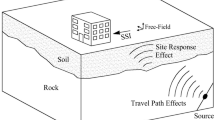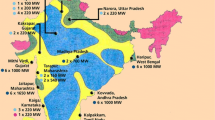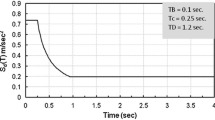Abstract
Regional seismic damage analysis of building clusters based on time history analysis enables damage evolution and distribution to be obtained for structural performance evaluation, seismic loss estimation, and post-earthquake emergency response decision support. Soil–structure cluster interaction (SSCI) effects have been shown to affect significantly seismic damage to buildings due to the influence of neighboring buildings through underlying soils. However, SSCI effects in current regional seismic damage simulations are either ignored or obtained with exceptionally high computation cost due to the common discretization of large scale soil domains using finite elements. To this end, lumped parameter models (LPMs) are presented in this work as a simple effective tool for regional seismic damage simulation of SSCI systems, which is particularly useful for parametric analysis and also enables fast regional damage assessments. The LPMs combine story-based multiple-degree-of-freedom buildings with ‘foundation springs’ that are used to represent soil–foundation interaction and foundation–soil–foundation interaction. Seismic damage analysis of 320 buildings on Wangjiang campus of Sichuan University in China is used as a case study. The results of the specific case study show, that in most cases, SSCI effects result in lower damage to buildings, especially on soft soils. However, the SSCI effects may lead to higher structural damage to buildings in some cases, e.g. those on stiff soils. The results also show that using nominal inter-story drift ratio which includes foundation rocking rotation as the damage index may underestimate story seismic damage to lower stories of tall buildings.












Similar content being viewed by others
References
ACI (2011) Building code requirements for structural concrete and commentary (ACI 318-11/318R11). American Concrete Institute, Farmington Hills, Michigan
Aldaikh H, Alexander NA, Ibraim E, Oddbjornsson O (2015) Two dimensional numerical and experimental models for the study of structure–soil–structure interaction involving three buildings. Comput Struct 150:79–91. https://doi.org/10.1016/j.compstruc.2015.01.003
Alexander NA, Ibraim E, Aldaikh H (2013) A simple discrete model for interaction of adjacent buildings during earthquakes. Comput Struct 124:1–10. https://doi.org/10.1016/j.compstruc.2012.11.012
ASCE (2016) Minimum design loads and associated criteria for buildings and other structures (ASCE/SEI 7-16). American Society of Civil Engineers, Reston
Bielak J, Loukakis K, Hisada Y, Yoshimura C (2003) Domain reduction method for three-dimensional earthquake modeling in localized regions, part I: theory. Bull Seismol Soc Am 93:817–824. https://doi.org/10.1785/0120010251
Clouteau D, Aubry D (2001) Modifications of the ground motion in dense urban areas. J Comput Acoust 9:1659–1675. https://doi.org/10.1142/S0218396X01001509
Dávalos H, Miranda E (2018) A ground motion prediction model for average spectral acceleration. J Earthq Eng 25:1–24. https://doi.org/10.1080/13632469.2018.1518278
Desroches R, Comerio M, Eberhard M, Mooney W, Rix GJ (2010) Overview of the 2010 Haiti earthquake. Earthq Spectra 27:1–21. https://doi.org/10.1193/1.3630129
FEMA (2001) HAZUS®99 Estimated annualized earthquake losses for the United State. Federal Emergency Management Agency, Washington, DC
FEMA (2012) Multi-hazard loss estimation methodology: earthquake model (HAZUS-MH 2.1). Federal Emergency Management Agency, Washington, DC
Gao YQ, Liu WF (2012) Statistical analysis of fundamental periods of frame-shear wall structures. Appl Mech Mater 174–177:2071–2078. https://doi.org/10.4028/www.scientific.net/AMM.174-177.2071
Ge Q, Xiong F, Xie L, Chen J, Yu M (2019) Dynamic interaction of soil–structure cluster. Soil Dyn Earthq Eng 123:16–30. https://doi.org/10.1016/j.soildyn.2019.04.020
Hori M (2006) Introduction to computational earthquake engineering. Imperial College Press, London
Hori M, Ichimura T, Wijerathne L, Ohtani H, Jian C, Fujita K, Motoyama H (2018) Application of high performance computing to earthquake hazard and disaster estimation in urban area. Front Built Environ 4:1. https://doi.org/10.3389/fbuil.2018.00001
Isbiliroglu Y, Taborda R, Bielak J (2015) Coupled soil–structure interaction effects of building clusters during earthquakes. Earthq Spectra 98:463–500. https://doi.org/10.1193/102412EQS315M
Kausel E (2010) Early history of soil–structure interaction. Soil Dyn Earthq Eng 30:822–832. https://doi.org/10.1016/j.soildyn.2009.11.001
Lagomarsino S (1993) Forecast models for damping and vibration periods of buildings. J Wind Eng Ind Aerodyn 48:221–239. https://doi.org/10.1016/0167-6105(93)90138-E
Lombaert G, Clouteau D (2006) Resonant multiple wave scattering in the seismic response of a city. Wave Random Complex 16:205–230. https://doi.org/10.1080/17455030600703574
Lombaert G, Clouteau D (2009) Elastodynamic wave scattering by finite-sized resonant scatterers at the surface of a horizontally layered halfspace. J Acoust Soc Am 125:2041–2052. https://lirias.kuleuven.be/handle/123456789/254448
Lorito S, Romano F, Atzori S et al (2011) Limited overlap between the seismic gap and coseismic slip of the great 2010 Chile earthquake. Nat Geosci 4:173–177. https://doi.org/10.1038/ngeo1073
Lou M, Wang H, Chen X, Zhai Y (2011) Structure–soil–structure interaction: literature review. Soil Dyn Earthq Eng 31:1724–1731. https://doi.org/10.1016/j.soildyn.2011.07.008
Lu X, Han B, Hori M, Xiong C, Xu Z (2014) A coarse-grained parallel approach for seismic damage simulations of urban areas based on refined models and GPU/CPU cooperative computing. Adv Eng Softw 70:90–103. https://doi.org/10.1016/j.advengsoft.2014.01.010
Lu X, Li M, Guan H, Lu X, Ye L (2015) A comparative case study on seismic design of tall RC frame-core-tube structures in China and USA. Struct Des Tall Spec 24:687–702. https://doi.org/10.1002/tal.1206
Lu Y, Marshall AM, Hajirasouliha I (2016) A simplified nonlinear sway-rocking model for evaluation of seismic response of structures on shallow foundations. Soil Dyn Earthq Eng 81:14–26. https://doi.org/10.1016/j.soildyn.2015.11.002
Lu X, Tian Y, Wang G, Huang D (2018a) A numerical coupling scheme for nonlinear time history of buildings on a regional scale considering site–city interaction effects. Earthq Eng Struct Dyn 47:2708–2725. https://doi.org/10.1002/eqe.3108
Lu Y, Hajirasouliha I, Marshall AM (2018b) Direct displacement-based seismic design of flexible-base structures subjected to pulse-like ground motions. Eng Struct 168:276–289. https://doi.org/10.1016/j.engstruct.2018.04.079
Lu X, McKenna F, Cheng Q, Xu Z, Zeng X, Mahin SA (2020a) An open-source framework for regional earthquake loss estimation using the city-scale nonlinear time history analysis. Earthq Spectra 36:806–831. https://doi.org/10.1177/8755293019891724
Lu Y, Li B, Xiong F, Ge Q, Zhao P, Liu Y (2020b) Simple discrete models for dynamic structure–soil–structure interaction analysis. Eng Struct 206:110188. https://doi.org/10.1016/j.engstruct.2020.110188
Miranda E, Taghavi S (2005) Approximate floor acceleration demands in multistory buildings. I: formulation. J Struct Eng 131:203–211. https://doi.org/10.1061/(ASCE)0733-9445(2005)131:2(203)
MOHURD (2005) Code for design of civil buildings (GB50352-2005). Ministry of Housing and Urban-Rural Development of the People’s Republic of China, Beijing, China
MOHURD (2010a) Code for design of concrete structures (GB 50010-2010). Ministry of Housing and Urban-Rural Development of the People's Republic of China, Beijing, China
MOHURD (2010b) Code for seismic design of buildings (GB50011-2010). Ministry of Housing and Urban-Rural Development of the People's Republic of China, Beijing, China
MOHURD (2010c) Technical specification for concrete structures of tall buildings (JGJ 3-2020). Ministry of Housing and Urban-Rural Development of the People's Republic of China, Beijing, China
MOHURD (2012) Load code for design of building structures (GB 50009-2012). Ministry of Housing and Urban-Rural Development of the People's Republic of China, Beijing, China
Mulliken JS, Karabalis DL (1998) Discrete model for dynamic through-the-soil coupling of 3-D foundations and structures. Earthq Eng Struct Dyn 27:687–710. https://doi.org/10.1002/(SICI)1096-9845(199807)27:73.0.CO;2-O
Poulos HG, Davis EH (1974) Elastic solutions for soil and rock mechanics. Series in soil engineering, Wiley
Rosenblueth E, Meli R (1985) The 1985 Mexico earthquake: causes and effects in Mexico City. Concr Int 8:23–34
Shi W, Lu X, Guan H, Ye L (2014) Development of seismic collapse capacity spectra and parametric study. Adv Struct Eng 17:1241–1255. https://doi.org/10.1260/1369-4332.17.9.1241
Sobhaninejad G, Hori M, Kabeyasawa T (2011) Enhancing integrated earthquake simulation with high performance computing. J Earthq Tsunami 42:286–292. https://doi.org/10.1016/j.advengsoft.2010.10.009
Steelman JS, Hajjar JF (2009) Influence of inelastic seismic response modeling on regional loss estimation. Eng Struct 31:2976–2987. https://doi.org/10.1016/j.engstruct.2009.07.026
Taborda R (2010) Three dimensional nonlinear soil and site-city effects in urban regions. Dissertation, Carnegie Mellon University
Taborda R, Bielak J (2011a) Large-scale earthquake simulation: computational seismology and complex engineering systems. Comput Sci Eng 13:14–27. https://doi.org/10.1109/MCSE.2011.19
Taborda R, Bielak J (2011b) Full 3D integration of site-city effects in regional scale earthquake simulations. In: Oral presentation at 8th international conference on structural dynamics, EURODYN. https://www.researchgate.net/publication/254200663
Tu T, Yu H, Ramirez-Guzman L, Bielak J, Ghattas O, Ma K, Hallaron DRO (2006) From mesh generation to scientific visualization: an end-to-end approach to parallel supercomputing. In: Proceedings of the 2006 ACM/IEEE conference on supercomputing. https://doi.org/10.1109/SC.2006.32
Vamvatsikos D, Cornell CA (2005) Direct estimation of seismic demand and capacity of multidegree-of-freedom systems through incremental dynamic analysis of single degree of freedom approximation. J Struct Eng 131:589–599. https://doi.org/10.1061/(ASCE)0733-9445(2005)131:4(589)
Vicencio F, Alexander NA (2018) Dynamic interaction between adjacent buildings through nonlinear soil during earthquakes. Soil Dyn Earthq Eng 108:130–141. https://doi.org/10.1016/j.soildyn.2017.11.031
Xiong C, Lu X, Guan H, Xu Z (2016) A nonlinear computational model for regional seismic simulation of tall buildings. Bull Earthq Eng 14:1047–1069. https://doi.org/10.1007/s10518-016-9880-0
Xiong C, Lu X, Lin X, Xu Z, Ye L (2017) Parameter determination and damage assessment for THA-based regional seismic damage prediction of multi-story buildings. J Earthq Eng 27:461–485. https://doi.org/10.1080/13632469.2016.1160009
Xiong C, Lu X, Huang J, Guan H (2019) Multi-LOD seismic-damage simulation of urban buildings and case study in Beijing CBD. Bull Earthq Eng 17:2037–2057. https://doi.org/10.1007/s10518-018-00522-y
Xu Z, Lu X, Guan H, Han B, Ren A (2014) Seismic damage simulation in urban areas based on a high-fidelity structural model and a physics engine. Nat Hazards 71:1679–1693. https://doi.org/10.1007/s11069-013-0972-8
Ye L, Lu X, Li Y (2010) Design objectives and collapse prevention for building structures in mega-earthquake. Earthq Eng Eng Vib 9:189–199
Zeng X, Lu X, Yang TY, Xu Z (2016) Application of the FEMA-P58 methodology for regional earthquake loss prediction. Nat Hazards 83:177–192. https://doi.org/10.1007/s11069-016-2307-z
Zhao W, Wen Z, Xu C et al (2018) Analysis of influence of floor lateral stiffness ratio on seismic vulnerability of masonry structures. Technol Earthq Disaster Prev 13:878–892. https://doi.org/10.11899/zzfy20180415
Zhou Y, Shi WX, Han RL (2012) Vibration test and analysis of the fundamental period of multi-story masonry structures with large-bay. Eng Mech 29:197–204. https://doi.org/10.6052/j.issn.1000-4750.2011.04.0200
Acknowledgements
The authors would like to acknowledge the financial support from National Natural Science Foundation of China (52008275), and the Sichuan Department of Science and Technology (2019YFH0120).
Author information
Authors and Affiliations
Corresponding author
Ethics declarations
Conflict of interest
The authors declare no potential conflict of interests.
Additional information
Publisher's Note
Springer Nature remains neutral with regard to jurisdictional claims in published maps and institutional affiliations.
Rights and permissions
About this article
Cite this article
Zhang, B., Xiong, F., Lu, Y. et al. Regional seismic damage analysis considering soil–structure cluster interaction using lumped parameter models: a case study of Sichuan University Wangjiang Campus buildings. Bull Earthquake Eng 19, 4289–4310 (2021). https://doi.org/10.1007/s10518-021-01149-2
Received:
Accepted:
Published:
Issue Date:
DOI: https://doi.org/10.1007/s10518-021-01149-2




